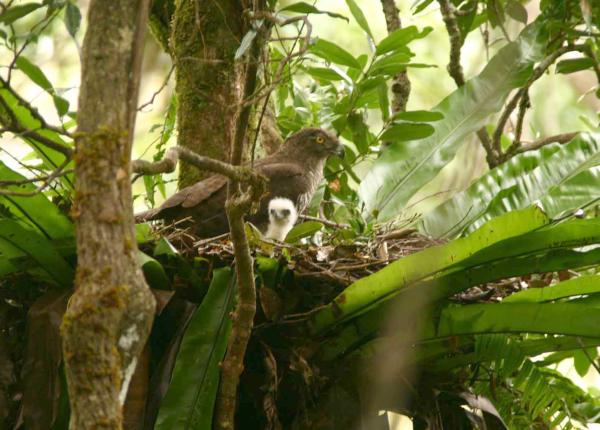Did You Know?
- Not long ago, scientists knew very little about this species. Only a few people had even reported seeing this eagle in the wild. However, in 1993, members of The Peregrine Fund field team captured and photographed a Madagascar Serpent-eagle. And they have been studying them ever since!
- At one nest, Peregrine Fund biologists observed that a fledged Madagascar Serpent-eagle was hunting on its own less than two weeks after it had left the nest for the first time.
How The Peregrine Fund is Helping
The Peregrine Fund has been studying the Madagascar Serpent-eagle since the early 1990s. Today, our Madagascar Program continues studying endangered and poorly known Malagasy raptors, developing local and national capacity in biodiversity conservation, and increasing the size of Madagascar's Protected Areas System. A very exciting success came in 2015 when, after years of working with local communities and government, three new areas were give status as "National Protected Areas." This victory has increased protected habitat by 190,000 hectares and will provide protection for an untold number of endangered species.
Where They Live
The Madagascar Serpent-eagle is endemic to the island of Madagascar. This eagle makes its home in primary rainforest and forest edges up to 1,000 m. It rarely ever ventures out beyond the edge of its forest home.
What They Do
The Madagascar Serpent-eagle is heavily barred along its breast, belly, and wing feathers. It has a long, banded tail. Another distinguishing characteristic is this bird's short but ample crest, which it can lift and lower at will. It has yellow eye and legs.
This eagle spends a large part of its day perched motionless below the forest canopy. They actually spend very little time flying or soaring. Scientists have described this species as "elusive and secretive." if you ever find yourself in this eagle's territory, the best way to find them is with your ears! Listen for a frog-like call coming from high up in the trees. They are especially vocal early in the mornings and sometimes late in the day, right before they go to roost.
Why They Need our Help
There is good news and bad news when considering the status of this distinctive eagle. First, the good news! After years of study, Peregrine Fund biologists and other researchers have shown that the Madagascar Serpent-eagle is actually more common than we once thought. Because of this, it isn't in imminent danger of extinction, as scientists once believed. However, the bad news is that this eagle lives within a very limited range inside the forests of northeastern Madagascar. If any of this forest is lost to clear-cutting or other threats, this eagle would be in serious trouble. Today, this species is categorized as Endangered.
What They Eat
With a name like "serpent-eagle" one would probably guess that this eagle feeds mostly on snakes. However, don't let the name fool you. The Madagascar Serpent-eagle actually feeds more frequently on lizards, including chameleons and geckos. It will also prey upon tree frogs, and less frequently, on snakes, bats and insects.
When on the hunt, the Madagascar Serpent-eagle usually sits on a perch, scanning its surroundings in search of something tasty to eat. After a few minutes, if it doesn't find anything, it will move on to the next branch and continuing to scan. It will sometimes snatch prey from the forest floor or flush prey from foliage with its feet.
Nests, Eggs, and Young
There is still so much scientists need to learn about the nesting habits of this marvelous bird. We do know that the birds fashion their nests out of sticks in well-hidden spots high up in trees, such as among epiphytes or within dense canopies.
The female will lay one white egg. Both the female and the male take turns incubating and protecting the egg, helping to make sure that the embryo inside develops into a healthy eaglet. After about 40 days, it will be time for the eaglet to hatch. The hatching process can be slow, with the tiny bird first making a small hole in the eggshell, then slowly breaking its way out. Once it hatches, the parents will stay very close by, keeping their offspring safe. During this time, the male will spend a lot of time hunting, making sure that there is enough food for him, the female, and his growing offspring. Once the nestling has grown to be about 3 weeks old, the female will leave the nest area and also help hunt food for her family. After around 60 days, the young eaglet will have grown to its parents' size and it will have developed its flight feathers. But even though it can fly, it will need to remain with its parents for a while as it learns to hunt and survive on its own.
References:
Global Raptor Information Network. 2021. Species account: Madagascar Serpent Eagle Eutriorchis astur. Downloaded from http://www.globalraptors.org on 27 Aug. 2021
Kemp, A. C. and D. A. Christie (2020). Madagascar Serpent-Eagle (Eutriorchis astur), version 1.0. In Birds of the World (J. del Hoyo, A. Elliott, J. Sargatal, D. A. Christie, and E. de Juana, Editors). Cornell Lab of Ornithology, Ithaca, NY, USA. https://doi.org/10.2173/bow.maseag1.01
Sheldon, B.C., and J.W. Duckworth. 1990. Rediscovery of the Madagascar Serpent-eagle Eutriorchis astur. Bulletin of the British
Ornithologists' Club 110:126-130.
Thorstrom, R., and L.-A. René de Roland. 2000. First nest description, breeding behaviour and distribution of the Madagascar Serpent-eagle Eutriorchis astur. Ibis 142:217-224.









